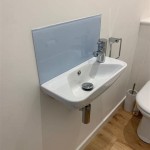How To Set a Drop-In Bathroom Sink
Installing a drop-in bathroom sink, also known as a self-rimming or top-mount sink, is a manageable project for a homeowner with basic plumbing and carpentry skills. The sink rests on the countertop, making it easier to install than other types of sinks. This article provides a step-by-step guide to ensure a successful installation.
Preparation and Safety Precautions
Before beginning any plumbing project, prioritizing safety and preparing the workspace is crucial. Gather all necessary tools and materials and ensure the water supply is shut off to the sink's location. This reduces the risk of water damage during the installation process.
Tools and Materials Required:
- New drop-in sink
- New faucet
- Supply lines (flexible supply tubes recommended)
- Drain assembly (P-trap, tailpiece, drain flange)
- Plumber's putty
- Silicone sealant
- Adjustable wrench
- Basin wrench (for tightening connections in tight spaces)
- Screwdriver set
- Measuring tape
- Pencil or marker
- Safety glasses
- Gloves
- Putty knife or scraper
- Clean rags
Shutting Off the Water Supply:
Locate the shut-off valves under the sink. These are typically small, oval-shaped valves on the water supply lines leading to the existing faucet. Turn both the hot and cold water valves clockwise until they are completely closed. If the valves are old or corroded and do not turn, locate the main water shut-off valve for the house and turn it off. After shutting off the water supply, open the existing faucet to relieve any remaining pressure in the lines. Place a bucket under the shut-off valves when disconnecting the old supply lines to catch any residual water.
Removing the Old Sink:
Before removing the old sink, disconnect the water supply lines from the existing faucet. Use an adjustable wrench to loosen the connections. Be prepared for some water to spill out, even after shutting off the supply. Next, disconnect the drain assembly. Loosen the slip nuts on the P-trap using a basin wrench or adjustable wrench. Carefully remove the tailpiece and P-trap. Once the plumbing connections are disconnected, inspect the underside of the sink where it meets the countertop. It is usually secured with clips, adhesive, or caulk. Remove any clips or screws. Use a putty knife or scraper to carefully break the caulk seal between the sink and the countertop. With the sink now free, carefully lift it out of the countertop opening. Clean the countertop surface thoroughly, removing any remaining caulk, adhesive, or debris. A clean surface is vital for proper adhesion of the new sink. Ensure the countertop is dry before proceeding.
Installing the New Faucet and Drain Assembly
Once the old sink has been removed and the countertop cleaned, the next step is to install the new faucet and drain assembly onto the new drop-in sink. This is generally easier to do before the sink is mounted to the countertop.
Faucet Installation:
Most new faucets come with detailed installation instructions. Refer to these instructions for the specific model you are installing. Generally, the process involves inserting the faucet body through the mounting holes in the sink. Secure it from underneath with the provided mounting hardware, which typically includes washers and nuts. Ensure the faucet is properly aligned and tightened according to the manufacturer's instructions. Connect the water supply lines to the faucet. If using flexible supply tubes, ensure they are the correct length to reach the shut-off valves. Tighten the connections securely, but avoid over-tightening, which can damage the fittings. Some faucets have a built-in sprayer or other features. Install these according to the manufacturer's instructions.
Drain Assembly Installation:
Apply a rope of plumber's putty around the underside of the drain flange. Press the flange into the drain opening in the sink. From underneath the sink, attach the other half of the drain assembly, including the rubber or plastic gasket and the mounting nut. Tighten the nut securely to create a watertight seal. Remove any excess plumber's putty from around the flange using a putty knife or your finger. Connect the tailpiece to the drain assembly. The tailpiece is the vertical pipe that extends down from the drain assembly. Tighten the slip nut that connects the tailpiece to the drain assembly. Depending on the sink, it might be necessary to install an overflow tube. If so, follow the manufacturer's instructions for this step.
Securing the Sink to the Countertop
With the faucet and drain assembly installed, the final step is to secure the sink to the countertop. This ensures a stable and watertight installation.
Applying Sealant:
Apply a bead of silicone sealant around the rim of the sink where it will contact the countertop. This sealant will create a waterproof barrier and prevent water from seeping under the sink. Choose a sealant that is specifically designed for bathroom use to resist mold and mildew growth. Ensure the countertop surface is clean and dry before applying the sealant.
Positioning and Securing the Sink:
Carefully lower the sink into the countertop opening. Ensure it is properly aligned and centered. Press down firmly on the sink to ensure good contact between the sealant and the countertop. Many drop-in sinks come with clips or brackets that are used to further secure the sink to the countertop. These clips attach to the underside of the sink and tighten against the underside of the countertop. Install these clips according to the manufacturer's instructions. Tighten them evenly to distribute the pressure and prevent cracking the sink. Use a damp cloth to wipe away any excess sealant that squeezes out from under the rim of the sink.
Connecting the Plumbing:
Connect the water supply lines to the shut-off valves. Tighten the connections securely using an adjustable wrench. Connect the P-trap to the tailpiece of the drain assembly. Ensure all connections are tight and leak-free. After connecting all plumbing lines, turn the water supply back on slowly. Check for leaks around all connections. If leaks are present, tighten the connections further. If leaks persist, disassemble the connection and inspect the fittings for damage or improper seating. Reapply pipe joint compound or Teflon tape if necessary. Inspect the drain for leaks by running water into the sink. Check the P-trap and all drain connections for any signs of leaks. Once the installation is complete and you are satisfied that there are no leaks, clean the sink and surrounding area. Remove any tools and debris from the workspace.
Testing the Installation:
Fill the sink with water and let it sit for a few minutes to check for any leaks around the drain. Drain the sink and check the drain connections underneath for leaks. Run both hot and cold water to ensure the faucet is working properly. Check the water temperature and flow rate. Turn the faucet on and off several times to check for any unusual noises or leaks. If the faucet has a sprayer, test it to ensure it is working properly. Check the countertop around the sink for any signs of moisture. If you find any moisture, dry it thoroughly and monitor the area for further leaks. After the installation is complete, wait the recommended drying time for the silicone sealant before using the sink extensively. This will ensure the sealant has properly cured and formed a watertight seal.
By following these steps, anyone can successfully install a drop-in bathroom sink, adding value and functionality to a home.

Homeowner S Guide To Drop In Bathroom Sinks The Family Handyman

Homeowner S Guide To Drop In Bathroom Sinks The Family Handyman

Drop In Bathroom Sink Replacement

How To Replace A Drop In Bathroom Sink Step By

Drop In Bathroom Sink Replacement

Ge Sealants How To Install A Drop Sink

How To Replace A Drop In Bathroom Sink Step By

Drop In Bathroom Sink Replacement

I5 Images Com Asr Deaa6301 E373 44b8 B12b 8

Rectangle Ceramic Sink Bathroom White Vessel Drop In W Faucet Pop Up Drain Set 728360148155
Related Posts







